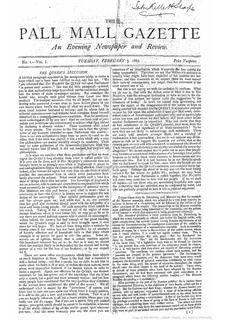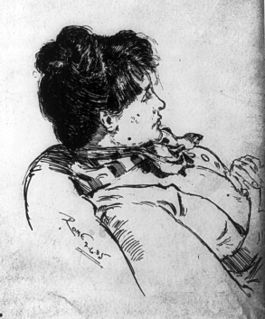
The Mall is a road in the City of Westminster, central London, between Buckingham Palace at its western end and Trafalgar Square via Admiralty Arch to the east. Near the east end at Trafalgar Square and Whitehall it is met by Horse Guards Road and Spring Gardens where the Metropolitan Board of Works and London County Council were once based. It is closed to traffic on Saturdays, Sundays, public holidays and on ceremonial occasions.

Marlborough House, a Grade I listed mansion in St James's, City of Westminster, London, is the headquarters of the Commonwealth of Nations and the seat of the Commonwealth Secretariat. It was built for Sarah Churchill, Duchess of Marlborough, the favourite and confidante of Queen Anne. For over a century it served as the London residence of the dukes of Marlborough. It became a royal residence through the 19th century and first half of the 20th. It was leased by Queen Elizabeth II to the Commonwealth Secretariat beginning in 1965.

Haymarket is a street in the St James's area of the City of Westminster, London. It runs from Piccadilly Circus in the north to Pall Mall at the southern end. Located on the street are the Theatre Royal, Her Majesty's Theatre, New Zealand House, a cinema complex and restaurants.

Pall Mall is a street in the St James's area of the City of Westminster, Central London. It connects St James's Street to Trafalgar Square and is a section of the regional A4 road. The street's name is derived from pall-mall, a ball game played there during the 17th century, which in turn is derived from the Italian pallamaglio, literally ball-mallet.

The Pall Mall Gazette was an evening newspaper founded in London on 7 February 1865 by George Murray Smith; its first editor was Frederick Greenwood. In 1921, The Globe merged into The Pall Mall Gazette, which itself was absorbed into The Evening Standard in 1923.

Frederick Greenwood was an English journalist, editor, and man of letters. He completed Elizabeth Gaskell's novel Wives and Daughters after her death in 1865.

George John Whyte-Melville was a Scottish novelist much concerned with field sports, and also a poet. He took a break in the mid-1850s to serve as an officer of Turkish irregular cavalry in the Crimean War.
The Criminal Law Amendment Act 1885, or "An Act to make further provision for the Protection of Women and Girls, the suppression of brothels, and other purposes," was an Act of the Parliament of the United Kingdom, the latest in a 25-year series of legislation in the United Kingdom of Great Britain and Ireland beginning with the Offences against the Person Act 1861. It raised the age of consent from 13 years of age to 16 years of age and delineated the penalties for sexual offences against women and minors. It also strengthened existing legislation against prostitution and homosexuality. This act was also notable for the circumstances of its passage in Parliament.
The Eliza Armstrong case was a major scandal in the United Kingdom involving a child supposedly bought for prostitution for the purpose of exposing the evils of white slavery. While it achieved its purpose of helping to enable the passage of the Criminal Law Amendment Act 1885, it also brought unintended consequences to its chief perpetrator, W. T. Stead.

The Incoherents was a short-lived French art movement founded by Parisian writer and publisher Jules Lévy(French) (1857–1935) in 1882, which in its satirical irreverence, anticipated many of the art techniques and attitudes later associated with the avant-garde and anti-art movements such as Dada.

"The Maiden Tribute of Modern Babylon" was a series of highly controversial newspaper articles on child prostitution that appeared in The Pall Mall Gazette in July 1885.

Elizabeth Robins Pennell was an American writer who, for most of her adult life, made her home in London. A recent researcher summed her up as "an adventurous, accomplished, self-assured, well-known columnist, biographer, cookbook collector, and art critic"; in addition, she wrote travelogues, mainly of European cycling voyages, and memoirs, centred on her London salon. Her biographies included the first in almost a century of the proto-feminist Mary Wollstonecraft, one of her uncle the folklorist Charles Godfrey Leland, and one of her friend the painter Whistler. In recent years, her art criticism has come under scrutiny, and her food criticism has been reprinted.

The British Institution was a private 19th-century society in London formed to exhibit the works of living and dead artists; it was also known as the Pall Mall Picture Galleries or the British Gallery. Unlike the Royal Academy it admitted only connoisseurs, dominated by the nobility, rather than practising artists to its membership, which along with its conservative taste led to tensions with the British artists it was intended to encourage and support. In its gallery in Pall Mall the Institution held the world's first regular temporary exhibitions of Old Master paintings, which alternated with sale exhibitions of the work of living artists; both quickly established themselves as popular parts of the London social and artistic calendar. From 1807 prizes were given to artists and surplus funds were used to buy paintings for the nation. Although it continued to attract members and visitors, in 1867, when the lease on its quarters expired, instead of renewing the society wrapped up its affairs.

Gallery Stratford is a public art gallery located in Stratford, Ontario, Canada. Founded in 1967, the Gallery has established itself as one of the region’s leading art galleries, organizing exhibitions of local, national and international visual artists. The gallery showcases contemporary work reflecting current changes in art making and pieces from its collection.
The Museum of Cultures of Lugano (MUSEC) was inaugurated on September the 23rd 1989 with the aim of preserving most of the ethnic artworks collected by Serge Birignoni and coming in particular from the Far East, India, South-East Asia, Indonesia and Oceania.

The New Gallery is a Crown Estate-owned Grade II Listed building at 121 Regent Street, London, which originally was an art gallery from 1888 to 1910, The New Gallery Restaurant from 1910 to 1913, The New Gallery Cinema from 1913 to 1953, and a Seventh-day Adventist Church from 1953 to 1992. After having been empty for more than ten years, the building was a Habitat furniture store from 2006 to 2011, and since September 2012 it is a flagship store for Burberry.

The Society of Women Artists (SWA) is a British art body dedicated to celebrating and promoting fine art created by women. It was founded as the Society of Female Artists (SFA) in about 1855, offering women artists the opportunity to exhibit and sell their works. Annual exhibitions have been held in London since 1857, with some wartime interruptions.
Pall Mall (1955–1978) was an Irish-bred, British-trained Thoroughbred racehorse and sire, best known for winning the classic 2000 Guineas in 1958. Owned and bred by Queen Elizabeth II, Pall Mall was one of the leading British two-year-olds of 1957, when he won the New Stakes at Royal Ascot and was placed in three other important races. In the following spring, he performed moderately in two trial races before creating a 20/1 upset by winning the 2000 Guineas. He later won the first two runnings of the Lockinge Stakes before being retired to stud, where he had some success as a sire of winners.

Blanche Baker (1844–1929) was a Bristol-born English watercolour artist who specialised in landscape paintings. She trained at the Bristol School of Art, and went on to exhibit regularly at the Royal Academy and with the Society of Lady Artists and the Camsix Art Club. She taught drawing in London schools, and her work documents extensive British and European travel. In 1902 she was elected a full member of the Bristol Academy.

Frances Caroline Fairman was a British watercolourist, a painter in oils, and an illustrator. In her lifetime she was best known for her canine portraits, some of which were commissioned by royalty and aristocracy. She was known as "the Lady Landseer" for the quality of her work. She travelled to the Americas, France, and Switzerland, returning with watercolour landscape sketches.
















